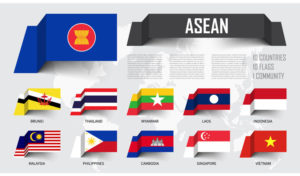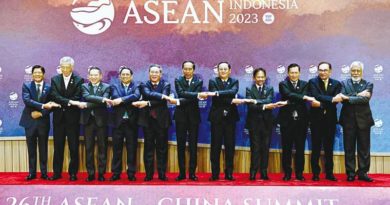ASEAN: Asean minus X syndrome
Myanmar crisis and the proposed expulsion of Cambodia and Laos from ASEAN are key characteristics of the Asean minus X syndrome.

This syndrome appears when Asean is seen as ineffective in addressing pressing regional issues through consensus or when one specific state is being perceived as having blocked the organisation from moving forward.
Thus, the proposed solution is that Asean should adopt a minus X decision-making process without the 10 countries consensus, and ultimately that X state should be expelled.

Article 21. 2. of the Asean Charter provides that, “In the implementation of economic commitments, a formula for flexible participation, including the Asean Minus X formula, may be applied where there is a consensus to do so.” It should be noted that Asean minus X procedure is applicable only in economic matters based on the consensus, which also includes the X state.
For expulsion of member state, Article 20. 4. is being referred to although not explicitly. The article provides that, “In the case of a serious breach of the Charter or non-compliance, the matter shall be referred to the Asean Summit for decision.”
Minus X syndrome is built based on the temptation to categorise and distinguish “bad member states” against “good member states”. Ultimately, minus X syndrome suggests that the so-called “good member states” would be given supranational power superseding that of other member states, which is the power to expel.
In support of the minus X syndrome, two theories are being used, namely the “vassal state theory” and the “rogue state theory”.
In the vassal state theory, possible accusations can be made based on, inter alia, the following points: subservience to interest of external powers, blocking of issuance of the Joint Communique, voicing of external parties’ interest and positions within Asean, possible hosting of foreign military bases, debt trap theory, over-reliance on specific powers, covert military agreements with external powers, etc.

In the rogue state theory, possible accusations can be made based on, inter alia, the following points: military coup, systematic abuses of human rights and fundamental freedoms, authoritarianism, dictatorship, one-party rule, non-democracy, genocide, crimes against humanity, lack of legitimacy and representation, etc.
When discussing about the minus X syndrome, “domino effect” and “tyranny of the majority” should be considered in tandem.
The key question for “domino effect” is that who will fall next? If one day 9 states can vote based on 9-countries consensus to expel one state, it also means that in the future 8 states will vote based on 8-countries consensus to expel another state.
In fact, there are a lot of issues in Asean that do not have consensus. If the consensus is abolished and expulsion can be made, then it would pave the way for mini-alliance working approach within the organisation based on issues or geopolitical orientation that divide the whole organisation because it is unlikely that all member states share the same position all the time.
Member states sometimes stand at the majority on one issue, but they can also stand at the minority on another issue.

Some member states look so close together against the so-called common threat, but such kind of strategic alliance should not be treated as a fundamental interest or even as the principle for the whole regional organisation, because history tells us that it can only be temporary. Some close allies are in fact the former foes, and the reverse is also true.
To sustain long term cohesiveness, a considerable amount of trust and mutual protection is needed; and for the case of Asean, it is the consensus-based modus operandi that plays the key role in that aspect.
This leads to the next point on prevention of the “tyranny of the majority”.
For sustainability of an entity that is so diverse in size, power, political orientation, and national characteristics, some forms of mechanisms need to be devised to ensure cohesiveness and unity between those entities.
For example, in the federal government of the US that has so many states with different size and power, the bicameral legislative system was established because the American Founding Fathers wanted to ensure that majority rules need to be balanced with minority interest, and to avoid governance being overrun by big powerful states. Furthermore, the framers of the US constitution also created the electoral college system to prevent presidential candidates from ignoring the needs of less populous states in favor of highly-populated ones.
Indeed, the organisation unity must be based on principles. The US constitution is also based on fundamental principles of human rights, but when some American states allowed slavery or racial segregation, issues that deal with the core values of the American constitution, does America need to delist those states from the federal government? How could America maintain unity of all 50 states for hundreds of years?
In fact, the interaction between differences of interest is even more complex for a community of multiple sovereign states that do not intend to form a federation, a union or a supranational organisation.
The association of independent sovereign states do not necessarily have common enemies or allies.
This is not to say that sovereign interest should jeopardise the regional interest either but states should have space to define what they consider as regional interest, and subsequently the regional grouping should be able to accommodate differences on definition and approach towards regional interest by each member state.

For example, when all states share common interest in terms of peace, states can diverge in terms of approaches towards peace; some opt for calculated tension, pressure, containment, confrontation and alliance-making to maintain peace and power balancing; some view that tension, mutual accusation, finger-pointing and over-securitisation of agenda should be avoided and prefer direct consultation, discrete communication and dialogue, stable management of differences, action-oriented practical cooperation, and trust building exercise to deter war.
As such, consensus is an important mechanism to adjust such kind of differences without having one definition and approach being dictated over the other. These differences should not be treated as betrayal based on temporary geopolitical divide, nor should they be treated as basis to judge that specific member states care less about regional interest, peace and stability than other member states.
Like how the federal government of the US has evolved over centuries, the development of Asean and interactions among sovereign member states in the association should be viewed through a long-term perspective with due consideration on nuances and differences, and the level of comfort for all members in pursuing what they all agree to be defined as regional interest for all.
According to the account on conception and evolution of Asean by the late Thai foreign minister Thanat Khoman, the idea to establish Asean was originally initiated when Thailand was brokering reconciliation among Indonesia, the Philippines and Malaysia over territorial disputes following the colonial legacy.
In fact, Asean was built based on differences and historical difficulties and it is not by chance that its Founding Fathers adopted the consensus decision-making procedure.











